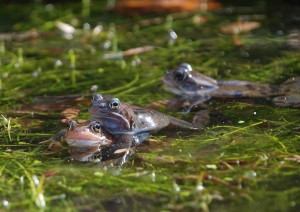 Despite the recent cold with ice and snow it will not be long before the frogs are back at their breeding sites. Some frogs will have hibernated under water as, unlike toads, they can absorb enough oxygen through their skin to survive the winter. Toads mate and lay their eggs often much later than frogs, depending on the weather, and have to leave their breeding sites at the end of the breeding season. They will later have to find hibernation in holes such as in the ground or under large logs. Unlike frogs that, if they leave the breeding site, tend to disperse over a wide area, toads will often gather together in a relatively small area. This is why sometimes you find many toads killed on a road by vehicles as they have left their hibernating site in some numbers.
Despite the recent cold with ice and snow it will not be long before the frogs are back at their breeding sites. Some frogs will have hibernated under water as, unlike toads, they can absorb enough oxygen through their skin to survive the winter. Toads mate and lay their eggs often much later than frogs, depending on the weather, and have to leave their breeding sites at the end of the breeding season. They will later have to find hibernation in holes such as in the ground or under large logs. Unlike frogs that, if they leave the breeding site, tend to disperse over a wide area, toads will often gather together in a relatively small area. This is why sometimes you find many toads killed on a road by vehicles as they have left their hibernating site in some numbers.
Frog activity is mainly triggered by rising temperatures, so if these are at 5 degrees C. or above for long periods they will start to move. On damp nights the males will keep calling and not only at night although they are more subdued during the day. Various interpretations have been made to describe the sound but one good one is that they sound like distant motorbikes. Frogs tend to vary in colour and this is for a number of reasons. They have the ability, for example, to slightly change their colour to blend in with their surroundings which helps with camouflage against the many predators. They can vary from light red to almost black and this can also depend on genes and water chemistry. One of the problems with laying eggs so early is that if they freeze all the eggs are frosted and lost. As they can only lay eggs once in a year this is a distinct disadvantage.
Freshly laid frogs’ spawn is almost blackish but they soon take in water and swell into the characteristic clumps. It is well worth remembering that one female frog only lays one clump so by counting you a get an idea of the numbers in each colony. Once the clumps have swollen really large they may merge with other clumps and separating them to count can be difficult. In contrast toads lay their eggs in long strings and wrap them round underwater plants. The female frogs are slightly larger than the males whereas, in contrast, the female toads may be twice as large as the males. Most frogs live for five or six years and keep growing so the larger the frog you see the older it is likely to be. Once the males and female get together the male grips the female tightly with its forelegs round the back of the female front legs. This solid grip is called amplexus and the males have soft swellings on the inner finger of each foot to get a grip and cling on. This “nuptial pad” is easy for us to see to help to sex frogs in the breeding season. The much larger hind legs of the males have no such pads but are used to kick away any other male rivals. The spawning takes place mainly at night and is rapid, lasting only seconds. Frogs have a wide range of predators from herons to large fish and crows to otters all of which take their toll especially where there is large frog colony.
The frogs in the photograph are in a very small garden pond near Inverness and these are males calling to attract females.
Tags: highland wildlife
